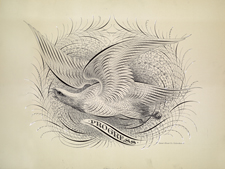Ornamental Penmanship on Display at Library Exhibit

The University of Scranton Weinberg Memorial Library is the new home for the Zaner-Bloser Penmanship Collection, which is one of the most extensive collections of American ornamental penmanship from the late 19th and early 20th centuries. Highlights from the collection will be on exhibit in the Heritage Room of the Weinberg Memorial Library from Tuesday, Feb. 1, through Monday, April 18.
According to Michael Knies, special collections librarian, the collection includes professional journals published for the practitioners of handwriting instruction and engrossing, rare handwriting manuals, and instructional material for children. The collection contains more than 20 scrapbooks containing examples of ornamental penmanship done by renowned master penmen. The period between 1875 and 1925 has been called the Golden Age of American Ornamental Penmanship, and this collection has examples by most of the great penmen of the era. There are also engraved printing blocks that were made from the original engrossings and pen flourishings.
“While handwriting manuals and master penman examples can be found in other libraries or private collections, the Zaner-Bloser Penmanship Collection appears to be the most extensive documentation of the Golden Age of American Ornamental Penmanship in the United States,” said Knies.
Zaner-Bloser Inc, based in Columbus, Ohio, a subsidiary of Highlights for Children (Honesdale, Pa.) since 1972, continues to be a leader in the field of penmanship instruction. The company was founded in 1888 in Columbus, Ohio, by Charles P. Zaner as the Zanerian School of Penmanship. Elmer W. Bloser purchased a share of the company in 1891 and in 1895 the school changed its name to the Zaner-Bloser Company. Originally, the school prepared students for careers as penmen. Penmen often worked in business, preparing ledgers, writing correspondence and creating documents before the invention of the typewriter. Zaner-Bloser also taught students to become teachers of penmanship, illustrators, engravers and engrossers. Engrossers employ the type of ornamental writing used for diplomas and certificates.
The company began publishing its own penmanship manuals. As the company history states: “In 1904, Zaner-Bloser published ‘The Zaner Method of Arm Movement,’ a landmark text that taught the simplified style of writing learned by students at the Zanerian to children in elementary schools all over the United States. This book also applied the findings of psychologists who had discovered that young children completed manual tasks more easily if allowed to use the large arm movements that were natural to them at their early stage of motor skills development.”
The collection came to the University as a result of a 2009 Hope Horn Gallery exhibit about Scranton-based engrosser P.W. Costello, curated by Thomas Costello, Michael Sull and Darlene Miller Lanning, Ph.D., director of the Hope Horn Gallery at The University of Scranton. P.W. Costello was an acclaimed penman whose work was published in Zaner-Bloser publications, which were borrowed for the exhibit. The company was looking for a home for its historical collections and expressed interest in the University. Knies visited Zaner-Bloser in January 2010 to survey the collection and discuss arrangements. Along with the material that came directly from Zaner-Bloser, Inc. additional material was donated by Sonya Bloser Monroe, granddaughter of company co-founder Elmer Ward Bloser.
The exhibit can be seen free of charge during library hours. For additional information, contact Knies at 941-6341.






